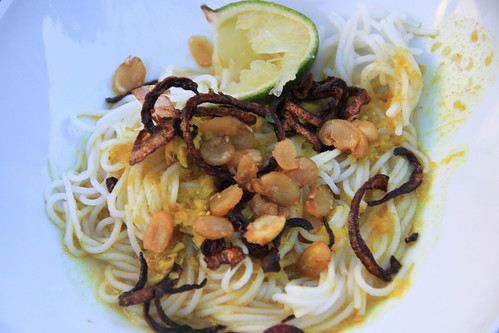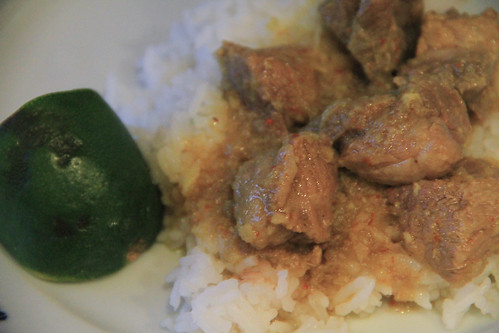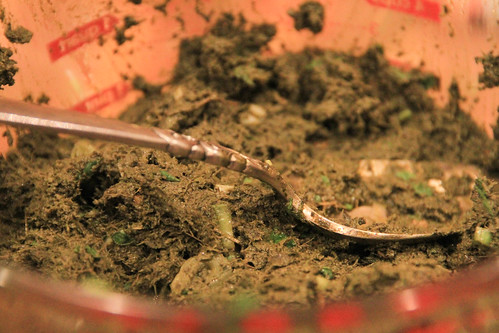Burmese food is intense. Funky, fiery, crunchy, soupy, tangy, herby…a full meal is a real workout for your palate. It bears some resemblance to Thai food, but with more crispy bits, more turmeric, and a lot more fermentation.
It’s also a good amount of work to prepare! A birthday gift of an outdoor street-vendor-style wok was extremely well timed, as there were several smelly, splattery things to be fried up. I’m never going to claim my cooking is authentic, but as I squatted next to the wok in the driveway in the mid-afternoon mid-summer heat, I felt like my approach was a bit closer to the on-the-ground reality than my normal induction-range cooking.
I’m also super lucky that there is a Burmese market in town. I’ve sung the praises of the highly global selection at Mingala before, but man, they really came through with every last ingredient I was looking for! I was the most grateful to find the fermented tea leaves, so I wouldn’t have to ferment them myself from scratch. (Though maybe I should have, as you'll see.)

(To address the Burma/Myanmar confusion: according to the BBC, they're essentially the common and literary version of saying the same word: "B" and "M" are both voiced consonants made with closed lips, for instance. The former is both the British colonial name as well as the democracy movement's preferred name, while the latter was instituted by the military junta and codified via its UN membership.)
It was a loverly summer evening so we enjoyed it outside with Pat, Debbie, Jeff, Denise, Chelsea, Al, Pan, Quinn, Lisa, Trish, Douglas, Kristen and friends.
Mohinga | Breakfast fish noodle soup | Recipe

The phrase “breakfast of champions” is overused, but a bowl of this rich, intense stuff is a pretty powerful way to get a day going — I certainly wouldn’t have conceived of it as a breakfast food were I not told it was. Yet this was a dinner, not a breakfast, but I cooked it anyway because pretty much everyone says it's the national dish.
You make a base from simmered catfish, aromatics like ginger and lemongrass, and shrimp paste, and then when it’s time for soup you simmer some of that paste with fish stock and then throw in some noodles. (I left out banana stem because I couldn't find any, and frankly I've never knowingly had it so I'm not sure what if anything we missed.) But arguably the best part is the crispy topping and tangy lime on top — I made beans and shallots, but there's a whole sub-cuisine just of of toppings you could do!
There's no question that there's a number of ingredients and several steps involved in making these soupy noodles. But if you're inspired and have the time, it's a great blend of flavors and textures.
Ohn-No Khao Swè | Coconut chicken noodle soup | Recipe

A different sort of noodle soup, more similar to Thai, with egg noodles and a coconut-curry base. (Though some Burmese might say that it's the Thai who got this dish from them and renamed it "khao soi"!)
Yes, I made two noodle soups. But they're so different! And I'm so glad I didn't let the first one get in the way of making this second one. It's a totally different type, with toothsome egg-wheat rather than soft rice noodles, and a rich, creamy, and subtler flavor rather than the much more punch-in-the-face mohinga. You could definitely make this with ingredients available at any Western supermarket: if you can't find gram flour just use a bit of wheat flour (preferably pan-toasted), and if you can't even find Asian egg noodles, any egg noodle (even the dry kind) would make for a decent substitute. In any event, I hope I remember this next time I'm jonesing for a chicken noodle soup with a twist, because it's pretty easy to make yet so satisfying to eat.
Pork curry | Recipe

Even after nearly 120 meals, I'm still finding novel cooking techniques. In this case, it's to separate the juice and the solids of the aromatics (onion, garlic, ginger) by blending and straining, using the liquid for simmering the meat, while separately frying the solids. For a curry, this has few seasonings — really, the only spices are turmeric and chili — and also requires quite a bit of attention to avoid browning the solids. I've never met a dish made with pork shoulder I didn't like, and this one was for sure tasty with that caramel-y depth from solid-sauteeing, though it didn't bring quite enough punch to make me want to make it again.
Lahpet thoke | Tea leaf salad | Recipe

If you’ve had the tea leaf salad at a place like Burma Superstar in San Francisco, with intriguingly tangy strands mixed in with cabbage and crunchy beans, apparently you were served the Westerner-friendly version. From what I’m led to understand, a true tea leaf salad in Myanmar is deconstructed, with a little pile of spicy, fermented tea leaves in the middle and surrounded by all sorts of other things to mix in.
Maybe I’ll stick to the Westernized version. The pre-prepared tea leaves were insanely intense: sour, spicy, and ferment-y in equal proportions. They were also were like spinach in how they make the back of your teeth feel. Really, it was more like an intense condiment than a salad. If anyone’s feeling adventurous, I’ve got one extra packet of these leaves that we didn’t end up opening… Though we didn't save you any of the crunchy fried-bean mix, that stuff was MSG-licious and went a long way in overcoming that intense tea-leaf flavor.
Many thanks to Emily for the advice on what to cook and buy!